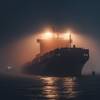Radiance of the Seas, the first of the Radiance-class of ships, was delivered to Royal Caribbean Cruise Lines (RCCL) on March 9. The 962 ft. (293.2 m), 90,090-ton vessel departed on March 11 from Amsterdam, en route to the Port of Miami, arrivng on March 21.
The 2,100-guest Radiance of the Seas is designed to sail world itineraries to Alaska, Hawaii, the Panama Canal, Pacific Northwest and the Caribbean. In addition to its slim, yacht like design with many glazed fronts, the ship is driven by an azipod propulsion system, and powered by smokeless, vibration-free GE gas turbine engines.
Built according to DNV Classification standards, Radiance was designed in close cooperation with its owners and optimized via computer calculations and model tests. The slim lines of the vessel with its 15 decks as well as the podded drive and innovative gas turbine system combine to deliver exceptional maneuvering and sea-keeping characteristics, and extremely low sound and vibration levels.
Equipped with a total of 1,050 passenger cabins, Radiance also features 200 cabins that are furnished with an intercommunicating door by which they can be converted to 100 double cabins, which are suited for families or large groups. In addition, the ship also has 14 cabins for passengers with disabilities. These spacious cabins are specially equipped to meet the requirements of handicapped passengers.
Divided into seven fire zones, the vessel meets the rules for a two compartment vessel and is designed in accordance with the latest IMO regulations. Evacuation materials consist of four tenders, 14 lifeboats and two fast rescue boats. The vessel is also equipped with two so-called Marine Evacuation Systems, which enable a quick evacuation via chutes onto the liferafts.
The ship's bridge area is outfitted with the IBS integrated bridge system by Litton Marine, which includes all components required to ensure safe navigation — even in much frequented and narrow waters. The bridge's main feature is the Voyage Management System, which allows the radar display and the electronic sea chart to be placed one above the other. All radar units have high resolution color monitors providing the navigator with advanced means of distinguishing between the different symbols used.
Subscribe for
Maritime Reporter E-News
Maritime Reporter E-News is the maritime industry's largest circulation and most authoritative ENews Service, delivered to your Email five times per week










